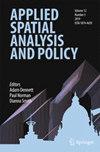The coastal community is confronted with heightened risks posed by climate change. Mobile Bay in the United States is a large estuarine system along the Gulf of Mexico (GOM) coast, providing critical ecosystem services for the nation. This region is however subject to increased urbanization and uncertain impacts of climate change. To ensure sustainability of this important ecosystem, it is imperative to examine the changing spatial patterns of community vulnerability to environmental changes in this region. Using data from the U.S. Census of multiple years, we investigate the changing spatial patterns of social vulnerability at the census block group level in Mobile Bay consisting of Mobile County and Baldwin County over the past 20 years (2000 – 2020). Additionally, we utilize hotspot and cluster analyses to formalize the observations of the spatiotemporal changes. Further, we examine how land use and land cover (LULC) changes co-occur with social vulnerability changes across Mobile Bay. We identify several hotspots where land cover has been converted to urban land and social vulnerability has increased. The investigation of the spatial patterns over a relatively long period helps to deepen the insight into the dynamic spatiotemporal changes of social and environmental vulnerability. This insight can better inform future plans to cope with climate change and ensure sustainability. Specifically, hotspots that have undergone urbanization and increased social vulnerability demand special attention from policy makers for future risk mitigation and disaster planning.




